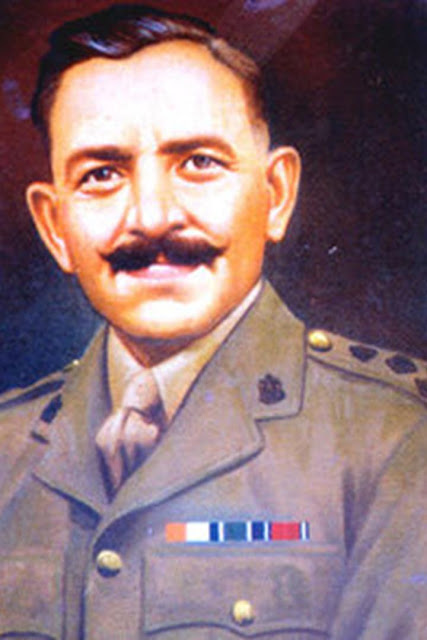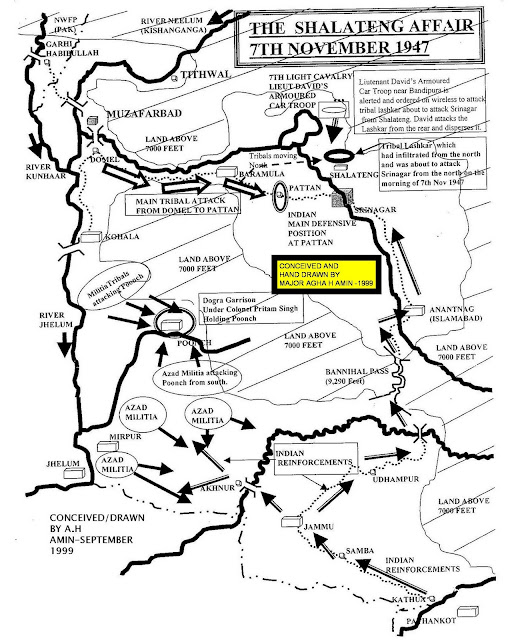Markus
SENIOR MEMBER

- Joined
- May 27, 2010
- Messages
- 4,425
- Reaction score
- -1
Brig Rajinder Singh: The Saviour of Kashmir
Come October and we remember Brig Rajinder Singh, MVC, (Posthumous) the Saviour of Kashmir. He was born on 14th June 1899 at Village Baguna (now Rajinder Pura) and Commissioned on 14th June 1921. he became Brig in May 1942 and took over as Chief of Staff J and K State Forces from Maj Gen H L Scot on 24th Sep 1947 when the State was, in fact an Independent Country. When Pakistan attacked Kashmir on 22th Oct 1947 and Maharaja Hari Singh was informed about the fall of Mazaffrabad. He ordered Brig Rajinder Singh:-
‘Brig Rajinder Singh is commanded to hold the enemy at Uri at all costs and to the last man.’
Accordingly Brig Rajinder Singh proceeded towards Muzaffrabad with a small Force of Hundred men. After inflicting heavy casualties on the invaders numbering 6,000 at Garhi he decided to blow Uri bridge and delay the Pakistani forces to enable Maharaja Hari Singh to carry out Accession Parleys so that Indian Army could move in to ultimately save the State and throw the invaders out.
After demolishing Uri Bridge he fought delaying actions at Uri, Mahura and Rampur inflicting heavy casualties to gain four days till he was ambushed at Buniyar on the night of 26/27th Oct 1947 and fately wounded but not before achieving a miracle, as the Indian Army landed within six hours after his last action to save the State. Thus we see Brig Rajinder Singh achieving the impossible as ordered by his Ruler ‘To the Last Man’, literally being the last man setting an example for the World which remains unparalled. It was also in Oct 1947, i.e. 26th Oct when Maharaja Hari Singh acceded J and K to the Indian Union after Brig Rajinder Singh his Chief of Staff had saved Kashmir. Brig Rajinder Singh thus became the Saviour of Kashmir and was awarded the first Gallantry Award of Independent India posthumously.
Now the contribution of Brig Rajinder Singh to the making of the Modern India, Maharaja Gulab Singh had founded this unique State which included the most Strategic area of the World now called the Northern Areas which was acceded to India on 26 Oct 1947 through Accession made possible by Brig Rajinder Singh.
Maharaja Hari Singh has also contributed in making the present History. Firstly the Dogra rulers never allowed a foot hold to the British in spite of many attempts to take over the control of the State particularly during Maharaja Partap Singh’s times. Even during World War II when the Britishers wanted the control of the strategic Gilgit Maharaja Hari Singh gave the area of Gilgit only on lease for 40 years which was returned by the British Govt. of India just before Independence in Jul 1947 when Maharaja Hari Singh sent Brig Ghansara Singh as Governor of Gilgit who continued to be the Governor till 1st Nov 1947even after the invasion of Kashmir by Pakistan on 21st Oct 1947 where Brig Rajinder Singh the Chief of Staff of J and K State Forces delayed their advance for four days upto 26 Oct. On the day of Accession Gilgit was with us and was acceded to India. Again it was possible due to Brig Rajinder Singh’s action to Save Kashmir.
Only if the Indian Govt. had sent a company worth troops to Gilgit before 1st Nov 1947 Gilgit and Baltistan would have never been lost as Pakistan never conquered these areas. It was Maj Brown Commander of the Gilgit Scouts serving under the Governor of Gilgit who had revolted and arrested the Governor on 1st Nov and handed over the entire area of Baltistan to Pakistan without a fight. Thus Maharaja Hari Singh’s contribution by signing the Instrument of Accession legally and constitutionally acceding the entire State to the Indian Union is his unique contribution in making of the History which in fact is the only legal authority for India to hold on to the State or ultimately to retrieve the lost areas, may be in the 21st century itself as the events are unfurling. Who made it possible. It was Brig Rajinder Singh.
Today we pay tribute to the Saviour of the State, Brig Rajinder Singh, MVC (Posthumous), recipient of the Independent Nation’s first Gallantry Award for which the State is justifiably proud. It is worth recalling two tributes paid to him on his Birth Centenary Celebrated by the State from 14th Jun 1999 to 14th Jun 2000 immediately after the Kargil War. These tributes are quoted for the younger generation:-
Tributes paid by Dr. Farooq Abdullah the, then Chief Minister now Minister for Renewable Energy.
“Today we are remembering Brig Rajinder Singh Ji. We are also getting an opportunity to remember officers and soldiers who have defended our State so far, so that we can sleep in peace. They are prepared to lay down their lives in our defence. God alone knows how many more may have become martyrs today so that we can live in peace. It is very necessary to remember them and also remember their difficulties.
If we have attained and preserved our freedom it is only due to the sacrifices of brave soldiers like Brig Rajinder Singh. Brig Rajinder Singh’s MVC is being upgraded to Param Vir Chakra, but for him even Bharat Ratna is less.
“I feel that in future we must make a “Veer Memorial”. The Veer Memorial should be so grand and imposing that we all go to it on 15th Aug and 26th Jan to pay our homage there. I would also like all newly married couples irrespective of whether they are Muslims, Hindus or Sikhs as a first step in their newly married life to go to Veer Memorial. There they should bow their heads in reverence to all those who gave their blood and sacrificed themselves and be thankful to them. It was they who enabled the newly weds to start their new lives in peace.”
Dr. Karan Singh, MP, Former Union Minister and Sadar-i-Riyasat J and K State, while paying tributes to Brig Rajinder Singh said “he was indeed a Hero of our times, having gallantly held off the invaders for several days, thus preventing the Kashmir valley from falling into hostile hands before the instrument of Accession could be signed.”
Brig Rajinder Singh: The Saviour of Kashmir





